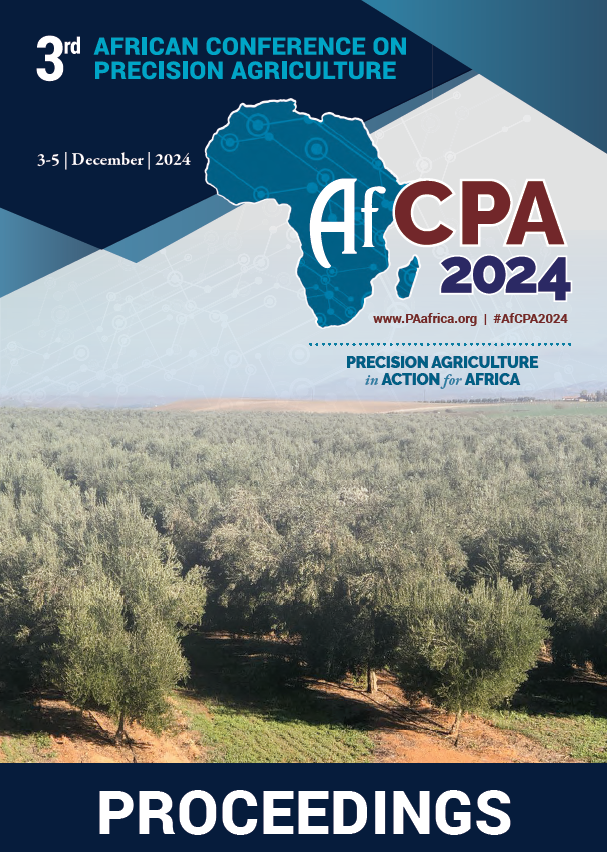Download the Conference Proceedings
Proceedings
Topics
| Filter results7 paper(s) found. |
|---|
1. Just a moment; the need for streamlining precision agriculture data in AfricaPrecision agriculture (PA) data sources in the era of digital agriculture are diverse in terms of the range of technology options and the types of data they generate. These include proximal sensors, unmanned aerial vehicle (UAV), satellites, farm machinery mounted sensors and robotics to generate static data or real time information (e.g., yield monitoring). Government institutions, scientists and private sectors take the lion’s share in generating PA data at innovation, validation and ... T.B. Gobezie, A. Biswas |
2. Evaluating Soil Organic Matter Under a No-Till System Using Digital Sensors (EM38 and MSP3)Agriculture, especially in no-till systems, plays a crucial role in ensuring global food security. The pressure on agricultural lands due to a growing population and climate change necessitates innovative solutions. Proximal soil sensing using electromagnetic induction (EMI) and electrical conductivity (ECa) sensors has gained prominence. These technologies provide rapid, non-destructive measurements of soil properties, offering advantages over remote sensing and laboratory analyses. ... H. Hajjaj, K. Ibno namr, E. Abdellah , C. El khalfi |
3. High Resolution Mapping of Long-Term Soil Organic Carbon Stocks and Changes in MoroccoSoil organic carbon (SOC) as a major part of the soil organic matter (SOM) is important for soil productivity stability and climate change mitigation. Current regional SOC maps are not detailed enough and thus, do not support decision-making at farm and landscape and do not track carbon long-term changes. Using large soil dataset, multispectral satellite data, climate data and machine learning , we created a high-resolution topsoil (0-30cm) map of Morocco and estimated t... B. Gerrard, E. Ben-dor, M. Bayad |
4. Development and Validation of an Algorithm for Optical Sensor-based Nitrogen Fertilization for Durum Wheat in Central Ethiopia I. Algorithm DevelopmentMonitoring in-season nitrogen (N) management using proximal optical sensors is often considered highly cost-effective and efficient. Developing a successful sensor-based algorithm to optimize in-season N application for durum wheat could enhance productivity and nitrogen use efficiency. This study aimed to develop and validate a sensor-based algorithm for N fertilization of durum wheat in central Ethiopia. The developed algorithm is based on the prediction of total N uptake from normalized di... S. Endris, T. Mesfin, O. Atnafu, S. Tamiru |
5. Assessing of Soil Nutrients Using Laboratory and Remote Sensing Methods in Northern Guinea SavannahIntroduction Soil nutrients are essential for plant growth and development, making their assessment crucial for sustainable agriculture and environmental management. The northern Guinea savannah region, known for its agricultural potential, requires periodic monitoring of soil nutrient status to ensure optimal crop yields and maintain soil fertility. This study aims to evaluate the effectiveness of laboratory and remote sensing techniques in assessing soil nutrients in this region.... A. Rabiu garba |
6. Toward Precision Agriculture by Assessing FAO Soil Data Accuracy with Localised Soil Mapping in Mid-Western UgandaProper soil mapping remains a major input for efforts that aim at developing context specific soil and crop management. Soil maps often enable policy makers and other agricultural extension programs to establish the suitability of land for various production systems. Currently, most soil maps have been developed basing in the FAO soil data bases at a scale of 1:50,000 yet farmers and other local land users require fine scales to guide decision in the use of fertilizers and selection of ... P. Musinguzi, E. Ojambo |
7. Assessing The Potential Of Drone Remotely Sensed Data In Detecting The Soil Water Content, And Taro Leaf Chlorophyll Content Across Different Phenological Stages... R. Masemola |
